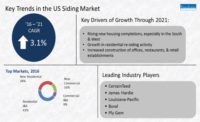Demand for gypsum products in North America is forecasted to advance 1.7 percent per year through 2009 to 50 million metric tons. Gains as measured in dollar value will rise 3.7 percent per year to $4.9 billion, an acceleration from the 1999-2004 period which saw gypsum board prices fall significantly. Growth in gypsum product value will be stimulated by a recovery in gypsum board pricing to the levels of the late '90s. These trends are presented in "Gypsum Products in North America," a new study from the Freedonia Group Inc.
Prospects for the North American gypsum industry are closely tied to the fortunes of the construction industry. The residential market plays a particularly important role, responsible for 60 percent of demand for gypsum products. Accordingly, the weak outlook through 2009 for the construction of new homes in the United States and Canada will result in a slowdown in demand for gypsum and gypsum products. This deceleration will be offset somewhat by an upswing in new nonresidential construction spending.
Gypsum board is the dominant gypsum product sold in North America, accounting for nearly three-quarters of total tonnage in 2004. Demand for gypsum board is expected to advance 1.5 percent per year to 41 billion square feet by 2009. In addition to gypsum board, other gypsum products include building and industrial plasters, gypsum used as a cement additive, agricultural gypsum and gypsum fillers. Gypsum used as an additive for cement is expected to lead gains. Growth in cement markets will be supported by a rebound in nonresidential construction in the states, as well as by continued efforts to rebuild infrastructure in Mexico.
Manufacturers of gypsum products continue to increasingly rely on synthetic gypsum-as opposed to mined gypsum-as a raw material. In 1994, synthetic gypsum accounted for only 6 percent of all gypsum consumed in North America. By 2004, synthetic gypsum had increased to 29 percent and by 2009 the share of synthetic gypsum is expected to rise to 38 percent. Most of the synthetic gypsum used in North America is supplied by coal-burning utilities that create the gypsum as a byproduct of the flue gas desulfurization (FGD) process. The use of FGD gypsum is particularly common in the gypsum board segment, with virtually all gypsum board plants built since 1998 using synthetic gypsum to fulfill all or part of their raw material requirements.
Get our new eMagazine delivered to your inbox every month.
Stay in the know on the latest in the wall and ceiling industry.
SUBSCRIBE NOWCopyright ©2024. All Rights Reserved BNP Media.
Design, CMS, Hosting & Web Development :: ePublishing


Report Abusive Comment